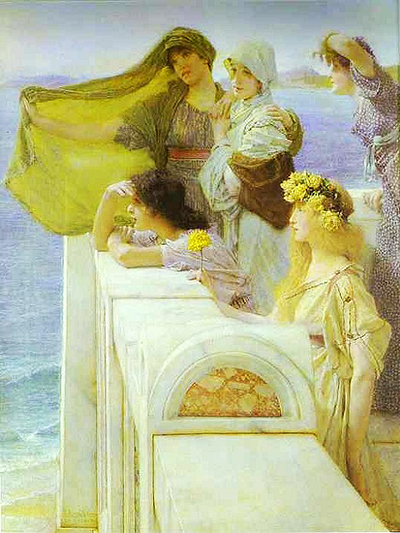At Aphrodite's Cradle is a painting by r Lawrence Alma-Tadema. The Oil on panel painting was painted in the early 20th century. Alma-Tadema who was a scholar of antiquity loved collecting artifacts, photographs, and engravings during the archaeological ventures at the time.
Alma-Tadema also worked to showcase the works of Homer, Plutarch, and Horace using sharp attention to detail as he superimposed figures which were relatable to his audience. In the painting, the five women showcase admiration and sympathy from the viewer. The crowded element of the picture creates a dynamic composition, at the same time presenting a beautiful image of the ladies. This picture is a representation of Alma-Tadema’s 3rd version of the subject in the painting, ‘The Coign of Vantage’ that was done in 1895, which resides in the Getty Museum, Malibu, California. The Coign painting expanded on the marble parapet with a bronze lioness figure on the ledge the woman is leaning on. Aphrodite’s Cradle does not have the sculpture, and it presents the coign as a narrow element, allowing a broader view of the sea.
In the earlier work, there were two large ships sailing, while At Aphrodite’s Cradle, the tension is high because the maidens are waiting for the men to arrive. In this scene, the maidens seem to be at Capri, where the exquisite villas are overlooking the sea. This painting is the final piece of the work commissioned by Agnew which was reinterpreting the theme of ‘The Coign of Vantage’. The painting is now in an exhibition in the United States.
The Aphrodite's Cradle seems to be the most complete scene of the three compositions as it isolates the women, and adds height to the position of the women. The posture and position of the women is a great representation of their anxious mood, which is as a result of their anticipation towards the men they await. This scene accompanies the verses of Horace, which refers to the offering that would be done towards Aphrodite, by the women on behalf of their lovers and husbands who are at war.




